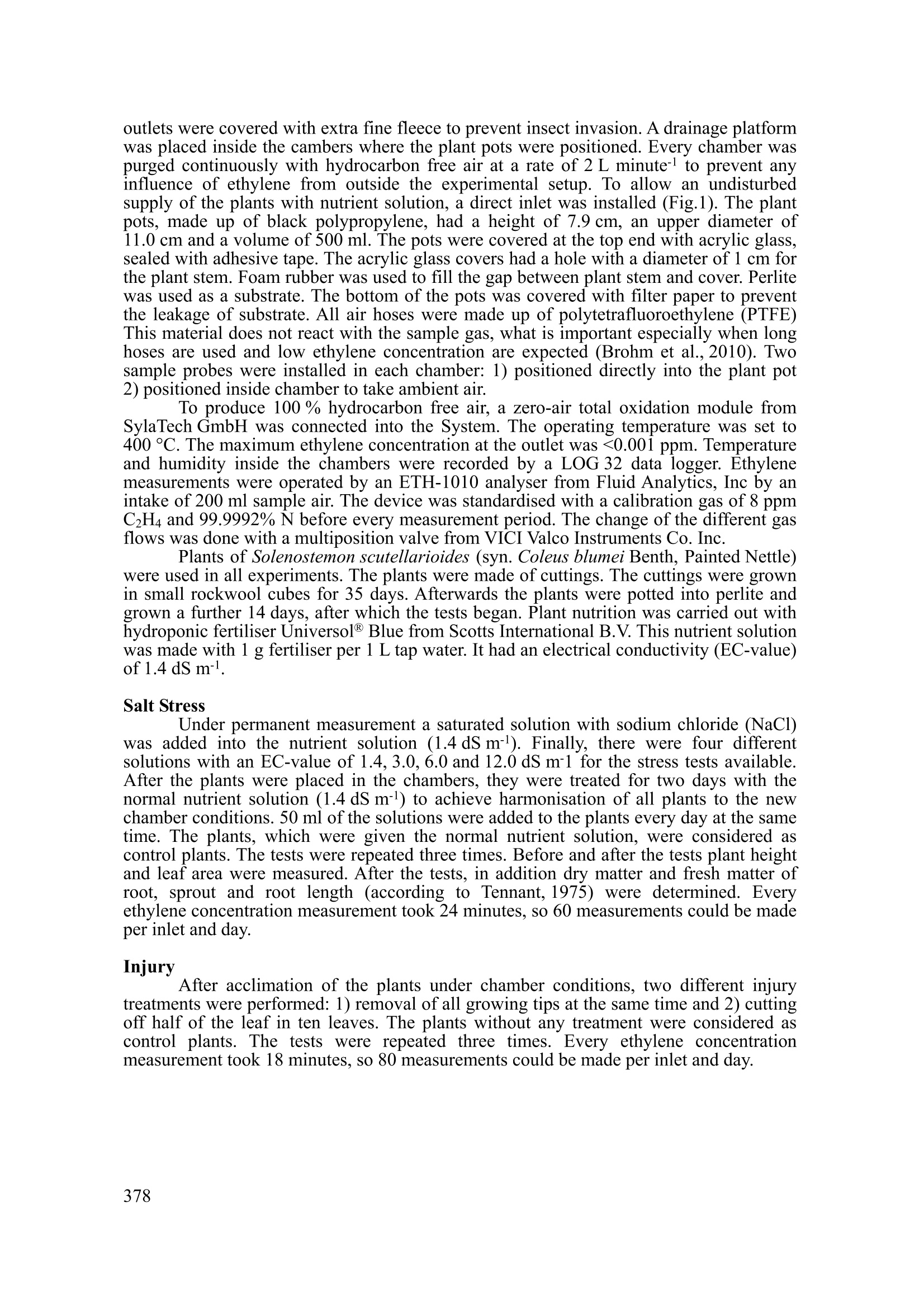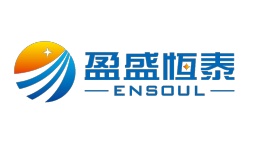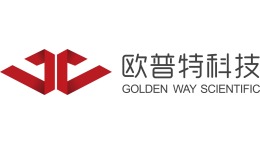方案详情文
智能文字提取功能测试中
Figures A Method for Plant Stress Detection by Online Ethylene Measurementin the Root Zone of Hydroponic Cultivated Plants D. Brohm, N. Domurath, S. Faber and F.-G. Schroder Faculty for Agriculture /Landscape Management University of Applied Sciences Dresden 01326 Dresden Germany Keywords: Solenostemon scutellarioides, painted nettle, salt stress, injury, ACC Abstract Detection of stressful situations of plants and crops presents a seductivepossibility to discover harmful circumstances before a permanent damage or losses ofharvest appear. For this aim, a new portable ethylene measurement device was testedin a small glass chamber setup. Hybrids of Solenostemon scutellarioides were stressedby high salt concentrations applied with the nutrient solution and by injury of upperparts. Sample air was taken in the root zone. During salt stress a change of the normalperiodic rhythm of the ethylene synthesis was noticed on all stressed plants. Noreaction in ethylene synthesis was noticed in the root zone after injury stress. INTRODUCTION The gaseous hydrocarbon ethylene (C2H4) is responsible for many different inter-actions in plants metabolism and development (Bleecker and Kende,2000). Even verylow concentrations in the ambient air (<1ppm) may influence plants constantly. However,ethylene is also produced by plant parts itself during ripening and in stressful situations atthe place of stress (Pierik et al., 2006). The spread of the stress signal may happen in threedifferent ways. Within the plant, an intercellular distribution of the gas is possible. Soplants react to their self-synthesised ethylene too. A chain reaction (positive feedbackregulation) causes the signal transmission over the whole organism (Petruzzelli et al.,2000). An active transport across the vascular bundles may occur through ACC(1-Aminocyclo-propane-1-carboxylic acid), a biochemical precursor of ethylene. How-ever, the ethylene may also diffuse out of the plant. So, a transfer of the stress signal toother individuals is possible too (Ruther and Kleier, 2005). Stressful situations always have a negative effect on the performance of livingorganisms (Brunold et al., 1996), even if the impact is not visible immediately. Plants arein the position to adapt to stress; nevertheless a reduction of their growth efficiency takesplace. Permanent stress causes damage or losses of yield. An aim of our tests is to showhow to measure ethylene as stress indicator with new techniques, to find a way to detectstressful situations before an influence or damages are visible. For this objective, saltstress and injury, two common stress situations, has been tested. Conventional measurements of plant stress signals has been realised by analysingACC,the biochemical precursor of ethylene. For these tests the plants had to be destroyedfirst. Also, detecting C2H4 by gas chromatography (GC) is possible, but has two dis-advantages: 1) a continuous measurement is not possible, because the handling of GCdoes not work automatically and, 2) the concentrations of plant released ethylene areoften too low for GC analysis (Jiang et al., 1998). An aim of these tests is to show thatethylene measurement is possible with modern measurement devices cheaper than GCand other expensive instruments. MATERIALS AND METHODS All tests were performed using four cubic glass chambers of 30 cm (volume: 27 L)within a warm greenhouse under a lightly shade to scatter the direct sunlight. The air ( "brohm@htw-dresden.de ) ( Proc. XXVIIIth I HC - IS on Envtl., Edaphic & Gen.FactorsAffecting Plants, Seeds and Turfgrass ) ( 1Acta Hort. 938, ISHS 2012 ) outlets were covered with extra fine fleece to prevent insect invasion. A drainage platformwas placed inside the cambers where the plant pots were positioned. Every chamber waspurged continuously with hydrocarbon free air at a rate of 2 L minute-to prevent anyinfluence of ethylene from outside the experimental setup. To allow an undisturbedsupply of the plants with nutrient solution, a direct inlet was installed (Fig.1). The plantpots, made up of black polypropylene, had a height of 7.9 cm, an upper diameter of11.0 cm and a volume of 500 ml. The pots were covered at the top end with acrylic glass,sealed with adhesive tape. The acrylic glass covers had a hole with a diameter of 1 cm forthe plant stem. Foam rubber was used to fill the gap between plant stem and cover. Perlitewas used as a substrate. The bottom of the pots was covered with filter paper to preventthe leakage of substrate. All air hoses were made up of polytetrafluoroethylene (PTFE)This material does not react with the sample gas, what is important especially when longhoses are used and low ethylene concentration are expected (Brohm et al., 2010). Twosample probes were installed in each chamber: 1) positioned directly into the plant pot2) positioned inside chamber to take ambient air. To produce 100% hydrocarbon free air, a zero-air total oxidation module fromSylaTech GmbH was connected into the System. The operating temperature was set to400C. The maximum ethylene concentration at the outlet was <0.001 ppm. Temperatureand humidity inside the chambers were recorded by a LOG 32 data logger. Ethylenemeasurements were operated by an ETH-1010 analyser from Fluid Analytics, Inc by anintake of 200 ml sample air. The device was standardised with a calibration gas of 8 ppmC2H4 and 99.9992% N before every measurement period. The change of the different gasflows was done with a multiposition valve from VICI Valco Instruments Co. Inc. Plants of Solenostemon scutellarioides (syn. Coleus blumei Benth, Painted Nettle)were used in all experiments. The plants were made of cuttings. The cuttings were grownin small rockwool cubes efs o1r0 135 days. Afterwards the plants were potted into perlite andgrown a further 14 days, after which the tests began. Plant nutrition was carried out withhydroponic fertiliser Universol Blue from Scotts International B.V. This nutrient solutionwas made with 1 g fertiliser per 1 L tap water. It had an electrical conductivity (EC-value)of1.4 dSm-1. Salt Stress Under permanent measurement a saturated solution with sodium chloride (NaCl)was added into the nutrient solution (1.4 dS m-). Finally, there were four differentsolutions with an EC-value of 1.4, 3.0, 6.0 and 12.0 dS m1 for the stress tests available.After the plants were placed in the chambers, they were treated for two days with thenormal nutrient solution (1.4 dS m-l) to achieve harmonisation of all plants to the newchamber conditions. 50 ml of the solutions were added to the plants every day at the sametime. The plants, which were given the normal nutrient solution, were considered ascontrol plants. The tests were repeated three times. Before and after the tests plant heightand leaf area were measured. After the tests, in addition dry matter and fresh matter ofroot, sprout and root length (according to Tennant, 1975)) were determined. Everyethylene concentration measurement took 24 minutes, so 60 measurements could be madeper inlet and day. Injury After acclimation of the plants under chamber conditions, two different injurytreatments were performed: 1) removal of all growing tips at the same time and2) cuttingoff half of the leaf in ten leaves. The plants without any treatment were considered ascontrol plants. The tests were repeated three times. Every ethylene concentrationmeasurement took 18 minutes, so 80 measurements could be made per inlet and day. RESULTS AND DISCUSSION Salt Stress During the first two days of the experiments all plants were fed with the sameoptimal nutrient solution (1.4 dS ml). At this time it was noticed, that the ethyleneconcentration trends of all plants were similar in its characteristic to each other, even ifthe absolute concentration differed. The data were set in relation by the percentage of themaximum ethylene concentration of each trend to qualify the measurements (Fig.2).Variations throughout the day are clearly visible. These variations are an indication of thecircadian rhythm of the plants. The circadian clock is responsible for an expression ofmultiple ACC SYNTHASE genes during the day (Thain et al., 2004), what causesethylene synthesis. The circadian clock depends not on outer influences, but it can besynchronised by light and temperature (Pittendrigh and Minis, 1964). As shown in Fig. 2 the similar trend in the relative concentration of ethylene in thefour plants before the initiation of the stress on the third day was disturbed from that pointon. These reactions in ethylene synthesis distinguish the stressed plants from the controlplants clearly. The treatment with higher salt concentrations disturbs the normal circadianday rhythm of ethylene synthesis, even with the lowest NaCl concentration (1.4 dS m).Higher ethylene synthesis rates of the stressed plants were found in the night time thanduring the day. Before the stress began, a big increase of ethylene synthesis was followedby a big decrease. Now a long period of high synthesis rate was noticed during the night,followed by a rapid decrease through the day. All plant parameters of these tests aresummarised in Table 1. A decrease of the increment of the whole plant substance causedby the increase of salt concentration is noticeable. Similar results have been observed byZapata et al. (2007). Injury Neither to plants with removed growing tips nor to cut leaf injury, showed nochanges in ethylene synthesis in the root zone compared to untreated plants (Fig.3). Rojoet al. (1999) described ethylene synthesis induced by injury stress only as a local reaction. Literature Cited Bleecker A.B. and Kende, H. 2000.Ethylene: A gaseous signal molecule in plants. Annu.Rev. CellDev. Biol.16:1-18. Brohm, D., Domurath, N. and Schroder, F.G. 2010. Multipunktuelle Online-Gasmessungin Pflanzen-und Lagersystemen. Proc. 46. Deutsche GartenbauwissenschaftlicheTagung Hohenheim, 24-27 February. p.172. Brunold, C., Riegsegger, A. and Brandle, R. 1996. Stress bei Pflanzen. Uni-Taschen-biicher, Stuttgart. Jiang, M., Gabler, R., Buscher,S., Kiihnemann, F., Lenz, F. and Urban, W. 1998. Contin-uous determination of ethylene from roots via laser photoacoustic spectroscopy.Gartenbauwissenschaft 63:49-54. Petruzzelli, L., Coraggio, I. and Leubner-Metzger, G. 2000. Ethylene promotes ethylenebiosynthesis during pea seed germination by positive feedbackk regulation of1-aminocyclo-propane-1-carboxylic acid oxidase. Planta 211:144-149. Pierik, R., Tholen, D., Poorter,H., Visser, E.J.W. and Voesenek, L.A.C.J. 2006. The janus face of ethylene: growth inhibition and stimulation. Trends in Plant Science 11:176-183.Pittendrigh, C.S. and Minis, D.H. 1964. The entrainment of circadian oscillations by lightand their role as photoperiodic clocks. The American Naturalist 98:261-294. Rojo, E., León J. and Sánchez-Serrano J.J. 1999. Cross-talk between wound signallingpathways determines local versus systemic gene expression in Arabidopsis thaliana.The Plant Journal 20(2):135-142. Ruther, J. and Kleier, S. 2005. Rapid communication- plant-plant signaling: ethylenesynergizes volatile emission in Zea mays induced by exposure to (Z)-3-hexen-1-ol.Journal of Chemical Ecology 31:2217-2222. Tennant D. 1975. A test of a modified line intersect method of estimating root length.Journal of Ecology 3:955-1001. Thain, S.C., Vandenbussche, F., Laarhoven, L.J.J., Dowson-Day, M.J., Wang Z.Y., Tobin,E.M., Harren, F.J.M., Millar, A.J. and Van Der Straeten, D. 2004. Circadian rhythmsof ethylene emission in Arabidopsis. Plant Physiology 136:3751-3761. Zapata, P.J., Botella, M.A., Pretel, M.T. and Serrano, M. 2007. Responses of ethylene bio-synthesis to saline stress in seedlings of eight plant species. Plant Growth Regulation53:97-106. Tables Table 1. Average values of measured plant parameters of treatments with different saltconcentrations of hydroponic cultivated plants of Solenostemon scutellarioides. Treatment EC-value 1.4 3 6 12 (dS m-) Leaf area before 261.3 213.6 156.4 157.9 (cm²) Leaf area after 384.6 342.9 212.5 200.1 (cm²) Leaf area increment 47.2 60.5 35.8 26.7 (%) Sprout length before 7.8 6.3 5.3 5.5 (cm) Sprout length after 10.5 9.5 7.5 6.8 (cm) Sprout length increment 35.5 52 42.9 22.7 (%) Sprout fresh matter 17 13.9 9.4 8 (g) Sprout dry matter 1.06 0.92 0.66 0.63 (g) Root fresh matter 5.72 4.4 4.15 3.26 (g) Root dry matter 0.45 0.37 0.17 0.18 (g) Root length 29.9 17.2 13.6 11.4 (m) 1Measurement right before the plants were put into the experimental setup. 2 According to Tennant (1975). Fig. 1. Schematic illustration of experimental setup. Fig. 2. Relative ethylene concentration measured in four plants of Painted nettle(Solenostemon scutellarioides), treated with four different salt concentrations. The*-sign points out the time of application of the salinity stress solution. 厅atsyto3oo3三 T3oat3一w3 ct一3x3 t一3x13 ds.: G.E. Welbaum et al. 为了生产100%无烃空气,Sylatech GmbH的零空气总氧化模块被连接到系统中。工作温度设定为400°C。出口处的最大乙烯浓度<0.001 ppm。室内的温度和湿度由log 32数据记录器记录。乙烯测量由来自Fluid Analytics公司的ETH-1010乙烯分析仪通过速率200 ml/mins样品空气进行操作。在每个测量周期之前,用8 ppm C2H4和99.9992%n的标定气体对装置进行标准化校准。不同气体流量的变化是VICI Valco Instruments Co. Inc多位置阀控制完成。
关闭-
1/6

-
2/6

还剩4页未读,是否继续阅读?
继续免费阅读全文产品配置单
图拉扬科技有限公司为您提供《水稻中乙烯检测方案(作物无损检测)》,该方案主要用于其他中乙烯检测,参考标准《暂无》,《水稻中乙烯检测方案(作物无损检测)》用到的仪器有null。
我要纠错
相关方案


 咨询
咨询





